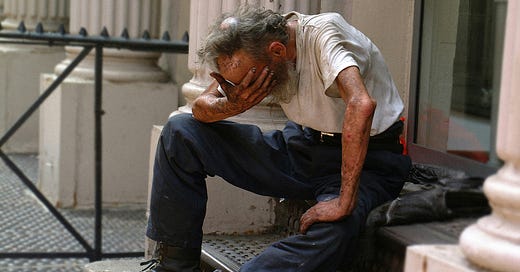Unsplash Photo Credit: Ben Hershey
Michele Steeb, author of the book, “Answers Behind the Red Door: Battling the Homelessness Epidemic,” pulls no punches in exposing the devastating failures of America’s current approach to homelessness.
As the crisis spirals out of control, Steeb’s indictment of government inaction is clear: our leaders have utterly failed to confront the root causes of homelessness, and nothing short of radical reform will suffice.
Her dissection of the Housing First model—now the bedrock of federal and state policies—demands urgent attention. She believes that the strategy is not just flawed; it’s exacerbating the very crisis it purports to solve.
America is now staring down a homelessness catastrophe of unprecedented scale, worsened by the influx of migrants into sanctuary states like Massachusetts, Colorado, and New York.
Massachusetts Governor Maura Healey’s controversial decision to impose time limits on homeless families in order to accommodate migrant arrivals has laid bare the callous neglect of our own citizens.
A Boston Globe exposé revealed the chilling consequences — hundreds of homeless children were placed in hotels alongside registered sex offenders, a fact that state officials initially sought to dismiss.
In cities like New York and San Diego, the situation is no less dire. Shelters are bursting at the seams, leaving families to fend for themselves on dangerous city streets.
In California, Governor Gavin Newsom’s recent executive order to clear encampments from state land is nothing more than a smokescreen, according to Steeb. She asserts that California’s single-minded reliance on Housing First—focusing solely on housing vouchers—has been a disaster, with the state now shouldering half of the nation’s unsheltered population.
Steeb’s scathing critique of Housing First is rooted in hard evidence. The model’s emphasis on immediate housing without addressing underlying issues like mental health, addiction, and joblessness has not only failed to alleviate homelessness—it has fueled its rise.
Programs that once offered comprehensive support, including therapy, life skills, and job training, have been gutted in favor of this one-dimensional approach. The result? Countless individuals left languishing on the streets, waiting for housing that may never come.
The fallout from this policy debacle is staggering. Steeb highlights a crucial 2009 decision by the Department of Housing and Urban Development (HUD) that redefined homelessness, excluding families living in motels or doubled up with others from the count.
This bureaucratic sleight of hand has led to a gross undercount of homeless families and left them ineligible for critical assistance. The gap between HUD’s official numbers and the Department of Education’s figures—over 1 million homeless K-12 students—reveals the true scope of this hidden crisis.
Drawing from her 13-year tenure as executive director of St. John’s Shelter in Sacramento, Steeb offers a stark contrast to the Housing First model. At St. John’s, women and children received more than just a roof over their heads—they were given the time and support to heal, learn, and rebuild their lives.
The success stories are undeniable: women who left the program with jobs, stability, and even homeownership, defying the odds in a state as unforgiving as California.
This is where Housing First falls painfully short. Without addressing the complex, underlying issues that drive homelessness, any attempt to provide housing is a stopgap at best.
Steeb argues that until we restore funding for comprehensive programs—those that address mental health, addiction, and job readiness—homelessness will remain an intractable problem.
Massachusetts serves as a grim warning to other states. Governor Healey’s policies have not only failed to protect homeless families but have actively endangered them.
The decision to place vulnerable children in hotels with sex offenders is particularly reprehensible, especially from a former top law enforcement official. This failure to confront the reality of family homelessness is a betrayal of our nation’s most basic values.
“Answers Behind the Red Door” is more than a book—it’s a rallying cry. Steeb calls for an urgent departure from the discredited Housing First model and a return to strategies that tackle the root causes of homelessness head-on.
It’s time to stop pretending that a roof alone can solve this crisis. Each homeless individual and family is unique, and our approach must reflect that reality.
As homelessness continues to surge, the lessons from Steeb’s work are impossible to ignore. Her book is essential reading for anyone who cares about the future of our cities and the lives of those left behind.
In a nation as wealthy as the United States, the failure to address homelessness is more than just poor policy—it’s a moral failing. The time for change is now.
Since January of 2020, Great Books, Great Minds has provided subscribers community, connection and conversation around books for free—no paywall.
But our future relies on you. At $6.00/month or $60.00 per year, please help me sustain our vision of impacting one million readers worldwide by 2030.
Diamond Michael Scott, Global Book Ambassador and Influencer







My understanding of the housing first model is that first, we get someone stabilized in housing, and then, we provide the other services, addressing mental health, addiction, and jobs etc. The idea is that in the stress and chaos of the streets, people can’t be expected to deal with these things successfully. Am I mistaken? Aren’t these services offered in the housing first model?